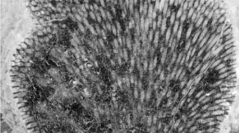

 Comptes Rendus Palevol
4 (6-7) - Pages 553-568
Comptes Rendus Palevol
4 (6-7) - Pages 553-568The transition from Permian to Triassic time, amidst the largest extinction in the history of life, is characterized by the loss of metazoan reefs followed by a protracted and total reorganization of reef ecosystems. This restructuring of reefs was permanent, and involved a succession from the Permian reef optimum to their total demise, followed by a long-term absence of metazoan reefs in the Early Triassic and then ultimately a delayed recovery in the Middle Triassic. During the end-Permian mass extinction, reef building metazoans suffered a major extinction that resulted in a severe drop in reef skeletal carbonate production by > 99%. Following the extinction, microbial reefs that formed without metazoans took over for 5–6 Myr during the entire Early Triassic. This microbial reef resurgence has been widely studied and is thought to represent long-term environmental stress related to the end-Permian mass extinction that suppressed the recovery of metazoans while simultaneously fostering microbialite development. In the Middle Triassic, metazoans reefs became re-established, although pre-extinction biodiversity values were not attained until the Late Triassic.
Early Triassic, microbial reefs, biotic recovery, End-Permian mass extinction